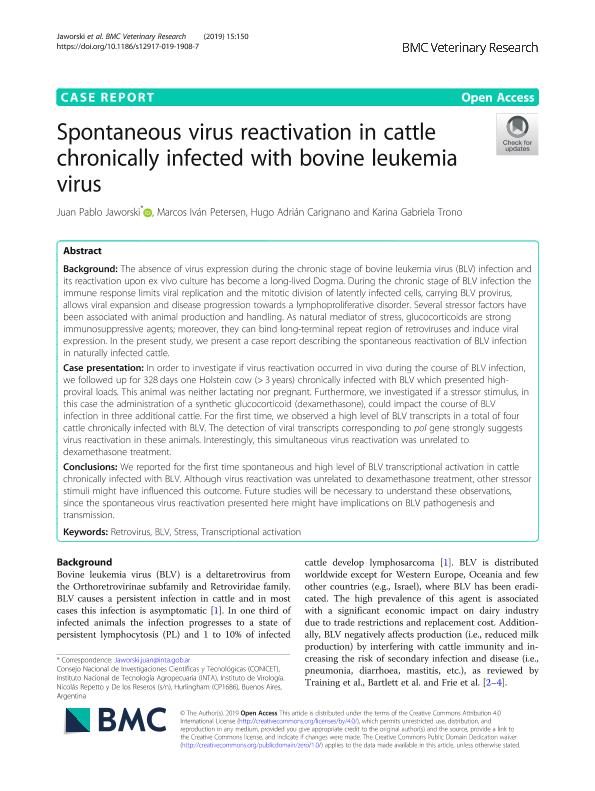Mostrar el registro sencillo del ítem
dc.contributor.author
Jaworski, Juan Pablo

dc.contributor.author
Petersen Cruceño, Marcos Iván

dc.contributor.author
Carignano, Hugo Adrián

dc.contributor.author
Trono, Karina Gabriela

dc.date.available
2020-12-02T14:24:45Z
dc.date.issued
2019-05
dc.identifier.citation
Jaworski, Juan Pablo; Petersen Cruceño, Marcos Iván; Carignano, Hugo Adrián; Trono, Karina Gabriela; Spontaneous virus reactivation in cattle chronically infected with bovine leukemia virus; BioMed Central; BMC Veterinary Research; 15; 1; 5-2019; 1-5
dc.identifier.issn
1746-6148
dc.identifier.uri
http://hdl.handle.net/11336/119587
dc.description.abstract
Background: The absence of virus expression during the chronic stage of bovine leukemia virus (BLV) infection and its reactivation upon ex vivo culture has become a long-lived Dogma. During the chronic stage of BLV infection the immune response limits viral replication and the mitotic division of latently infected cells, carrying BLV provirus, allows viral expansion and disease progression towards a lymphoproliferative disorder. Several stressor factors have been associated with animal production and handling. As natural mediator of stress, glucocorticoids are strong immunosuppressive agents; moreover, they can bind long-terminal repeat region of retroviruses and induce viral expression. In the present study, we present a case report describing the spontaneous reactivation of BLV infection in naturally infected cattle. Case presentation: In order to investigate if virus reactivation occurred in vivo during the course of BLV infection, we followed up for 328 days one Holstein cow (> 3 years) chronically infected with BLV which presented high-proviral loads. This animal was neither lactating nor pregnant. Furthermore, we investigated if a stressor stimulus, in this case the administration of a synthetic glucocorticoid (dexamethasone), could impact the course of BLV infection in three additional cattle. For the first time, we observed a high level of BLV transcripts in a total of four cattle chronically infected with BLV. The detection of viral transcripts corresponding to pol gene strongly suggests virus reactivation in these animals. Interestingly, this simultaneous virus reactivation was unrelated to dexamethasone treatment. Conclusions: We reported for the first time spontaneous and high level of BLV transcriptional activation in cattle chronically infected with BLV. Although virus reactivation was unrelated to dexamethasone treatment, other stressor stimuli might have influenced this outcome. Future studies will be necessary to understand these observations, since the spontaneous virus reactivation presented here might have implications on BLV pathogenesis and transmission.
dc.format
application/pdf
dc.language.iso
eng
dc.publisher
BioMed Central

dc.rights
info:eu-repo/semantics/openAccess
dc.rights.uri
https://creativecommons.org/licenses/by/2.5/ar/
dc.subject
BLV
dc.subject
RETROVIRUS
dc.subject
STRESS
dc.subject
TRANSCRIPTIONAL ACTIVATION
dc.subject.classification
Ciencias Veterinarias

dc.subject.classification
Ciencias Veterinarias

dc.subject.classification
CIENCIAS AGRÍCOLAS

dc.title
Spontaneous virus reactivation in cattle chronically infected with bovine leukemia virus
dc.type
info:eu-repo/semantics/article
dc.type
info:ar-repo/semantics/artículo
dc.type
info:eu-repo/semantics/publishedVersion
dc.date.updated
2020-11-30T14:17:46Z
dc.journal.volume
15
dc.journal.number
1
dc.journal.pagination
1-5
dc.journal.pais
Reino Unido

dc.journal.ciudad
Londres
dc.description.fil
Fil: Jaworski, Juan Pablo. Instituto Nacional de Tecnología Agropecuaria. Centro de Investigación en Ciencias Veterinarias y Agronómicas. Instituto de Virología; Argentina. Consejo Nacional de Investigaciones Científicas y Técnicas; Argentina
dc.description.fil
Fil: Petersen Cruceño, Marcos Iván. Instituto Nacional de Tecnología Agropecuaria. Centro de Investigación en Ciencias Veterinarias y Agronómicas. Instituto de Virología; Argentina. Consejo Nacional de Investigaciones Científicas y Técnicas; Argentina
dc.description.fil
Fil: Carignano, Hugo Adrián. Instituto Nacional de Tecnología Agropecuaria. Centro de Investigación en Ciencias Veterinarias y Agronómicas. Instituto de Virología; Argentina. Consejo Nacional de Investigaciones Científicas y Técnicas; Argentina
dc.description.fil
Fil: Trono, Karina Gabriela. Instituto Nacional de Tecnología Agropecuaria. Centro de Investigación en Ciencias Veterinarias y Agronómicas. Instituto de Virología; Argentina. Consejo Nacional de Investigaciones Científicas y Técnicas; Argentina
dc.journal.title
BMC Veterinary Research

dc.relation.alternativeid
info:eu-repo/semantics/altIdentifier/url/https://bmcvetres.biomedcentral.com/articles/10.1186/s12917-019-1908-7
dc.relation.alternativeid
info:eu-repo/semantics/altIdentifier/doi/http://dx.doi.org/10.1186/s12917-019-1908-7
Archivos asociados
